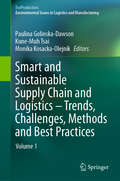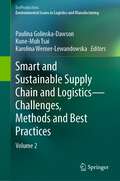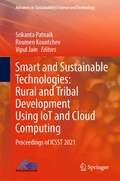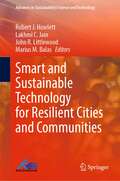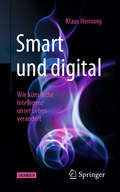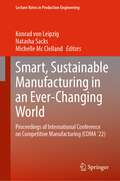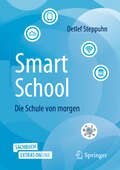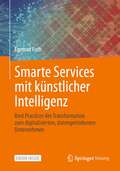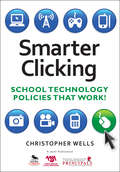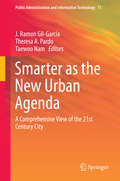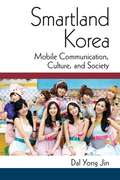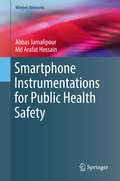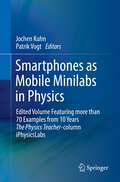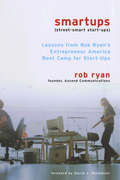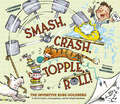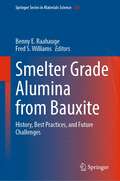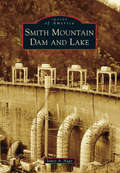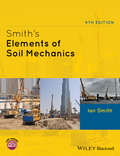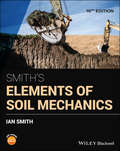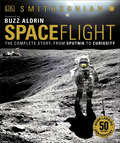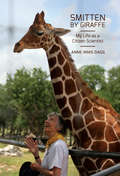- Table View
- List View
Smart and Sustainable Supply Chain and Logistics – Trends, Challenges, Methods and Best Practices: Volume 1 (EcoProduction)
by Paulina Golinska-Dawson Kune-Muh Tsai Monika Kosacka-OlejnikThis book discusses the critical contemporary issues of sustainability and integration of physical and information flow. It explores the digitalization of logistics processes and the need for a more integrated and a seamless cooperation in supply chain management, which are dominant trends in business practice. Moreover, it examines how the pressure for CO2 emission reductions and more resource- efficient business models influences the organization of logistics operations on both a local and global scale, demonstrating that integrating physical and cyber systems is necessary to achieve a more environmentally friendly, safe logistics and supply chain operations. In the individual chapters, the authors discuss the new qualitative and quantitative theoretical methods and models and also analyze case studies from business practice. This book provides valuable insights for academics, Ph.D. students and practitioners wishing to deepen their understanding of logistics operations and management.
Smart and Sustainable Supply Chain and Logistics — Challenges, Methods and Best Practices: Volume 2 (EcoProduction)
by Paulina Golinska-Dawson Karolina Werner-Lewandowska Kune-Muh TsaiThe application of artificial intelligence methods and the increasing digitalization of the processes in a supply chain contribute the more seamless flow of materials and information. The disturbances in global supply chain during pandemic put pressure on companies to improve the existing operations. The Sustainable Development Goals put pressure on local and global markets to reduce carbon dioxide emissions and to implement a more resource-efficient business model. Integration of physical and cyber systems is necessary to achieve more environmentally friendly, efficient logistics and supply chain operations. This book presents the contemporary issues of sustainability and integration of physical and information flow in supply chain. In the individual chapters, the authors discuss new qualitative and qualitative theoretic methods, models and present case studies from business practice. This book might be a valuable source of knowledge for the academics, PhD students and practitioners to deepen their knowledge in the field of logistics and SCM.
Smart and Sustainable Technologies: Proceedings of ICSST 2021 (Advances in Sustainability Science and Technology)
by Vipul Jain Srikanta Patnaik Roumen KountchevThis book presents a collection of peer-reviewed best selected research papers presented at the First International Conference on Smart and Sustainable Technologies (ICSST 2021), organized by Department of ECE, GIET University, Gunupur, Rayagada, Odisha, India, during December 16–18, 2021. The proceedings of the conference have a special focus on the developments of local tribe and rural people using smart and sustainable technologies. It is an interdisciplinary platform for researchers, practitioners, and educators as well as NGO workers who are working in the area of web engineering, IoT and cloud computing, Internet of Everything, data science, artificial intelligence, machine learning, computer vision, and intelligent robotics, particularly for the rural and tribal development.
Smart and Sustainable Technology for Resilient Cities and Communities (Advances in Sustainability Science and Technology)
by Lakhmi C. Jain Robert J. Howlett John R. Littlewood Marius M. BalasThis book is a collection of extended versions of papers presented at the KES Covid-19 Challenge international summit. The book focusses on technological, economic, and social developments to combat the effects of global and local disasters as well as the ways in which the recovery from Covid can be used to build more resilient and sustainable communities, industry, and improve the environment. It also discusses the global challenges of human-influenced climate change. There are chapters on making cities and communities more resilient through energy self-sufficiency, food production, resilient housing and buildings, human health and intelligent systems e.g. for forecasting and prediction.
Smart und digital: Wie künstliche Intelligenz unser Leben verändert
by Klaus HenningKünstliche Intelligenz verändert alles.Dieses Buch ermutigt, sich der Herausforderung durch die digitale Transformation mit Künstlicher Intelligenz zu stellen. Der Leser erfährt, warum diese Transformation als größte Kulturrevolution seit der Erfindung des Massenbuchdrucks anzusehen ist und wie diese wert-orientiert positiv gestaltet werden kann. Dabei verfolgt der Autor die These, dass Intelligente Objekte im Netz und Gegenstände dieser Welt ein eigenes Bewusstsein bekommen. Er zeigt anhand vieler Beispiele, wie diese digitalen Begleiter zu unseren digitalen Partnern werden. Dieses Sachbuch gibt viele Anregungen für das eigene Lebens- und Arbeitsumfeld und ist voller Beispiele für die Umsetzung von Systemen der künstlichen Intelligenz. Der Leser erfährt, was heute schon geht und was in den nächsten zehn bis zwanzig Jahren zu erwarten ist. Das Werk ist für alle interessant, die sich für KI und die digitale Transformation interessieren – von Verantwortlichen in Unternehmen, öffentlichen Einrichtungen und Politik, wie auch alle Lehrer und Eltern, die verstehen wollen, was die nächste Generation erwartet.
Smart, Sustainable Manufacturing in an Ever-Changing World: Proceedings of International Conference on Competitive Manufacturing (COMA ’22) (Lecture Notes in Production Engineering)
by Konrad Von Leipzig Natasha Sacks Michelle Mc ClellandThis book presents recent developments, research results, and industrial experience to increase the knowledge base of academics and industry. In a small world where trade is the new global driving force conquering countries and continents alike, international competitiveness is becoming the ultimate challenge. It requires high-quality products manufactured with state-of-the-art technologies at low cost under the assumption of highly efficient operations management as well as clear corporate goals and strategy. This in turn is based on improved engineering training and education, relevant applied research, and an active interaction between academia and industry.
SmartSchool - Die Schule von morgen
by Detlef SteppuhnDer technologische Wandel gewinnt rasant an Tempo – alle Schulen müssen sich dieser Herausforderung zeitnah stellen. Dieses Sachbuch erläutert, welche Technologien warum in Schulen zum Einsatz kommen müssen und welche besonderen Fortbildungs- und Supportkonzepte sie wirklich benötigen, wozu SmartTeams gebraucht werden und welche Bedeutung Robotik, KI, Virtual Reality, eSports und Wettbewerbe für den Unterricht haben. Alle Beteiligten erhalten viele Anregungen, Tipps, Ideen und Beispiele für den erfolgreichen Weg zu einer – auch, wenn viele das Wort noch scheuen – SmartSchool. Kritisch hinterfragen die Autoren, warum es (noch) keine guten digitalen Unterrichtsmaterialien gibt und warum Schulen und Schulträger intensiver zusammenarbeiten müssen. Denn SmartSchools sind die Schulen von morgen! - Mit Online-Zusatzmaterialien.
Smarte Services mit künstlicher Intelligenz: Best Practices der Transformation zum digitalisierten, datengetriebenen Unternehmen
by Egmont FothIn diesem Buch erfährt der Leser, wie smarte Services mit künstlicher Intelligenz realisierbar sind und wie eine digitale Transformation gelingt, mit der sich die Kundenorientierung, Wettbewerbsfähigkeit, Widerstandsfähigkeit, Agilität und Nachhaltigkeit von Unternehmen verbessern lässt. Was sind smarte Services und wie sehen sie in der Praxis aus? Was beinhalten die dafür erforderlichen Komponenten Internet of Things, Data Lake und Advanced Analytics? Wofür lässt sich die künstliche Intelligenz einsetzen und wie erfolgt das in der Praxis? Wie entsteht Digital Trust? Wie lässt sich der digitale Reifegrad von Unternehmen ermitteln? Welches Vorgehen hat sich für die digitale Transformation in der Praxis bewährt? Wofür wird ein digitales Ecosystem benötigt und wie kann es aussehen? Was wird unter „New Work“ verstanden? Wie arbeiten datengetriebene Unternehmen und welche Vorteile hat das? Was ist ein Digital Use Case? Wie läuft ein Use-Case-Entwicklungs-Workshop ab? Wie lässt sich ein Digital Use Case strukturiert beschreiben? Welche interessanten, innovativen Beispiele für Digital Use Cases gibt es? Wie erfolgt ein Proof of Concept? Wie lassen sich die Kernprozesse Order to Cash (O2C), Procure to Pay (P2P), Design to Operate (D2O), Recruit to Retire (R2R) und Awareness to Advocacy (A2A) digitalisieren? Welche neuen digitalen Technologien und in ihrem Zusammenhang angewandte Verfahren existieren?
Smarter Clicking: School Technology Policies That Work!
by Christopher W. WellsDevelop safe technology practices that support learning and protect your school, staff, and students! Designed to support appropriate use of technology for teaching and learning, this comprehensive guide gives school leaders a clear road map for creating, implementing, and maintaining effective instructional technology policies. In jargon-free terms, Wells explains legal considerations and offers case studies and concrete strategies to help educators: Evaluate their school’s needs Involve stakeholders in a collaborative effort Protect student and staff privacy Respond to challenges presented by social networking and emerging technologies Avoid inappropriate, costly use of technology Develop acceptable use policies
Smarter as the New Urban Agenda
by J. Ramon Gil-Garcia Theresa A. Pardo Taewoo NamThis book will provide one of the first comprehensive approaches to the study of smart city governments with theories and concepts for understanding and researching 21st century city governments innovative methodologies for the analysis and evaluation of smart city initiatives. The term "smart city" is now generally used to represent efforts that in different ways describe a comprehensive vision of a city for the present and future. A smarter city infuses information into its physical infrastructure to improve conveniences, facilitate mobility, add efficiencies, conserve energy, improve the quality of air and water, identify problems and fix them quickly, recover rapidly from disasters, collect data to make better decisions, deploy resources effectively and share data to enable collaboration across entities and domains. These and other similar efforts are expected to make cities more intelligent in terms of efficiency, effectiveness, productivity, transparency, and sustainability, among other important aspects. Given this changing social, institutional and technology environment, it seems feasible and likeable to attain smarter cities and by extension, smarter governments: virtually integrated, networked, interconnected, responsive, and efficient. This book will help build the bridge between sound research and practice expertise in the area of smarter cities and will be of interest to researchers and students in the e-government, public administration, political science, communication, information science, administrative sciences and management, sociology, computer science, and information technology. As well as government officials and public managers who will find practical recommendations based on rigorous studies that will contain insights and guidance for the development, management, and evaluation of complex smart cities and smart government initiatives.
Smartland Korea: Mobile Communication, Culture, and Society
by Dal Yong JinThe dramatic advancement of cellphone technology has fundamentally changed our daily lives. Smartphones and their applications have created new capital for information and communication technology corporations and changed the way people communicate. Because of an interesting awareness of the significance for digital economy and people’s daily culture, many countries, from the U.S. to China, have massively invested in the smartphone industries since the early 21st century. Among them, South Korea has become one of the centers for technology development and digital culture, although the country was once lagging behind in the penetration of the phones and their apps. Yet within the last few years, the country has taken a big step toward their goal of becoming a ‘mobile game wonderland’ by appropriating smartphones and it now exists as a curious test-bed for the future of smartphone technology. Smartland Korea, as the first attempt to comprehensively analyze mobile communication in the context of Korean smartphones, looks into a largely neglected focus of inquiry, a localized mobile landscape, with particular reference to young Koreans’ engagement with their devices and applications. Dal Yong Jin focuses not only on the celebratory achievement of technological advancement, but also the significance of social milieu in the development of the smartphones. He situates the emergence of smartphones within the growth of mobile technologies and overall telecommunications industries embedded in Korea’s information and communication technologies. The book examines the technology’s innovation and the evolution, the digital economy through the lens of political economy, and the youth culture embedded in the Korean smartphone context.
Smartphone E-commerce: Your Step-by-step Guide On How To Maximize Sales In Your Mobile E-commerce Store
by Benjamin GundgaardMAXIMIZE your mobile e-commerce sales! <P><P>This step-by-step guide enables you to create world-class smartphone e-commerce stores that maximize your online sales!As Tamara Adlin, CEO at Adlin Inc. and former Customer Experience Manager at Amazon.com, puts it: "Implement even a few of Gundgaard's guidelines and watch your conversion climb!" <P><P>Here's what you get with Smartphone E-commerce:Best practice online shop templates & checklists to build an entire mobile store <P><P>This book guides you through all aspects of how to create lucrative e-commerce stores for smartphones, specifically tailored to maximize your profits and customer satisfaction in the future of online shopping. <P><P>Smartphone E-commerce provides you with templates & 204 guidelines for all parts of your smartphone e-commerce
Smartphone Energy Consumption
by Sasu Tarkoma Matti Siekkinen Eemil Lagerspetz Yu XiaoWith an ever-increasing number of applications available for mobile devices, battery life is becoming a critical factor in user satisfaction. This practical guide provides you with the key measurement, modeling, and analytical tools needed to optimize battery life by developing energy-aware and energy-efficient systems and applications. As well as the necessary theoretical background and results of the field, this hands-on book also provides real-world examples, practical guidance on assessing and optimizing energy consumption, and details of prototypes and possible future trends. Uniquely, you will learn about energy optimization of both hardware and software in one book, enabling you to get the most from the available battery power. Covering experimental system design and implementation, the book supports assignment-based courses with a laboratory component, making it an ideal textbook for graduate students. It is also a perfect guidebook for software engineers and systems architects working in industry.
Smartphone Instrumentations for Public Health Safety (Wireless Networks)
by Abbas Jamalipour Md Arafat HossainA significant and convenient approach to detection and analysis of biological, environmental and agricultural items is the harnessing of features in widely available smartphones to create field-deployable scientific instruments, allowing measurements to be made onsite and in real-time. This book will cover a number of self-contained smartphone instruments with the particular focus on spectroscopic-based measurements. Measurement and analysis on precision of such low-cost instrumentations are provided to compare with more expensive commercial equipment. This book also discusses some limitations, possible recommendations and scopes for further instrumentations using smartphones and other smart devices. Particularly, the opportunity to integrate the devices into the global Internet-of-Things (IoT) platform will be discussed. Researchers and instrumentation designers in optical and photonic sensing, smart and IoT-based sensing, biological and environmental analysts, agricultural, and food quality researchers (and public health authorities) will find this book useful as reference. Students in science and engineering disciplines for teaching and educational purposes will also find this book useful as a secondary textbook.
Smartphones as Mobile Minilabs in Physics: Edited Volume Featuring more than 70 Examples from 10 Years The Physics Teacher-column iPhysicsLabs
by Jochen Kuhn Patrik VogtThis book presents more than 70 physics experiments from iPhysicsLabs-column of the Journal The Physics Teacher. The articles are aimed at physics lecturers, trainee teachers and teachers who want to take their classes to the next level using digital devices. The experiments can easily be performed and analyzed using smartphones or tablets. The topics span from mechanics, optics, thermodynamics, astrophysics and astronomy to acoustics, electrodynamics and electronics.Authors worldwide have contributed to this series of articles. To celebrate the 10th anniversary of iPhysicsLabs, Jochen Kuhn and Patrik Vogt have collected more than 70 most popular and interesting articles for this book.
Smartups
by Rob RyanBuilding successful start-ups was never quite as easy as it seemed, and the changing economic climate has raised the stakes, reduced the margin of error. New entrepreneurs can't stumble into wealth on the power of half-formed ideas, or turn dreams into reality without doing a lot of homework. It's time to get smart. This book teaches would-be entrepreneurs the skills they need to get through the venture capital process with companies that will survive to grow and succeed. Rob Ryan, a pioneer in the high-tech industry, founded Ascend Communications in 1989, and throughout the nineties provided firms with the infrastructure they needed to keep up with the rapid growth of the Internet. At the beginning of 1999, Ascend was sold to Lucent for $25 billion. Since retiring from Ascend and starting Entrepreneur America, Ryan has helped launch a string of successful companies, including Virtmed, RightNow, and Virtual Ink. All provide electronic solutions to real-world problems, meet existing-rather than manufactured-needs, and save their customers time and money. In Smartups, Ryan focuses on methods he's developed over the years for building a sustainable business that makes money. He emphasizes the importance of testing ideas on customers and making sure that a product offers something new and important. Recognizing a team's key competencies is crucial, Ryan says. He also finds it necessary to take certain steps at the correct stages of a company's inception. Smartups will show you how to turn your idea into a real product, take it to investors, and get your start-up started right.
Smash Trash! (Step into Reading)
by RH DisneyMeet WALL•E in this Step 1 reader! It is the 29th Century and the Earth has been abandoned, but one robot has been left behind to collect and condense trash—WALL•E. This Step 1 Step into Reading book introduces early readers to Disney/Pixar WALL•E.
Smash, Crash, Topple, Roll!: The Inventive Rube Goldberg—A Life in Comics, Contraptions, and Six Simple Machines
by Catherine ThimmeshA joyfully illustrated picture book biography of Rube Goldberg for STEM-loving children and the many people who enjoy doing simple tasks the hard way.Award-winning author Catherine Thimmesh’s irresistibly engaging text and artist Shanda McCloskey’s energetic, cartoon-style artwork introduce readers to the life and creative legacy of Rube Goldberg, the world-famous inventor of crazy contraptions. A rollicking educational kids' book that is part biography, part inspiration, and part physics how-to, Smash, Crash, Topple, Roll! posits the ultimate question … why do anything the simple way? (Especially if, for instance, there is a catapult option?) Because, of course, there are lots of things you can do the simple way: Set an alarm, flip a switch, open a door, toast some bread . . . But what if, instead, you did things the Rube Goldberg way? Endlessly entertaining, needlessly complex, and achieving a delicate balance of physics, humor, and excitement! The book includes an overview of the six simple machines that power most of Goldberg’s inventions and puts the tools for making real-life Rube Goldberg machines right into readers’ hands. It’s the perfect thing to spark the imaginations of budding inventors, artists, and thinkers of all ages—because the most promising relationships with science start not with a textbook but with the willingness to break stuff and ask silly questions!SCIENCE MADE FUN: Sure to excite students, teachers, and parents looking for a playful, hands-on way to dive into the sciences and connect to STEM and STEAM efforts in schools, where Rube Goldberg machines are already in use, this book offers a fun way to approach the sometimes-daunting subject of physics. INSPIRATIONAL AWESOMENESS: There are more and better opportunities for kids to embrace and explore a love of science and engineering today, and Rube Goldberg was an artist, too! This is the perfect book to encourage the scientist and artist in every kid. POPULAR SUBJECT FOR KIDS: There are over 1 million views of various Rube Goldberg videos on YouTube featuring overly complicated ways to turn a page, pass the salt, water a plant, and more.Perfect for: Young makers Parents, grandparents, and caregivers encouraging budding engineers and artists Classroom book or gift for teachers Rube Goldberg fans of all ages
Smelter Grade Alumina from Bauxite: History, Best Practices, and Future Challenges (Springer Series in Materials Science #320)
by Benny E. Raahauge Fred S. WilliamsThis book provides a comprehensive review of the production of smelter grade alumina from bauxite ores. It emphasizes the best practices applied in the industry today but seen in a historical context with a view to future challenges and developments. The control of alumina quality is discussed in detail including the effects that alumina quality have on the aluminum smelter process with respect to environmental performance, current efficiency, and metal purity. The discussion of alumina quality will be relevant to people on the smelter side, as this is the interface between refinery and smelter. Emphasis is placed on the major steps of the Bayer Process including: digestion, clarification, precipitation, calcination, and management of water, energy, and bauxite residue. This book is a valuable resource for active, seasoned practitioners and for new engineers entering the industry.
Smith Mountain Dam and Lake (Images of America)
by James A. NagyThe construction of a dam in the gap of Smith Mountain in Pittsylvania County, Virginia, had been considered as early as the 1920s. However, the dam's construction did not begin until 1960. Smith Mountain Dam closed the gap completely in 1963, and Smith Mountain Lake began to fill and form behind it. The hydroelectric dam consists of 175,000 cubic yards of concrete and has the capacity to generate 605 megawatts of electricity for up to 11 hours. Smith Mountain Dam is part of a two-dam system on the Roanoke River, and its companion dam, the Leesville Dam, is a smaller structure designed to pump water back to Smith Mountain Lake and to also generate hydroelectric power for American Electric Power (AEP) customers. Smith Mountain Lake covers 20,000 acres and has a 500-mile shoreline, which borders Franklin, Pittsylvania, and Bedford Counties. Over the years, development near and around Smith Mountain Lake has exploded, and this has presented both opportunities and challenges in regard to stewardship of the area's natural resources.
Smith's Elements of Soil Mechanics
by Ian SmithThe 9th edition maintains the content on all soil mechanics subject areas - groundwater flow, soil physical properties, stresses, shear strength, consolidation and settlement, slope stability, retaining walls, shallow and deep foundations, highways, site investigation - but has been expanded to include a detailed explanation of how to use Eurocode 7 for geotechnical design. The key change in this new edition is the expansion of the content covering Geotechnical Design to Eurocode 7. Redundant material relating to the now defunct British Standards - no longer referred to in degree teaching - has been removed. Building on the success of the earlier editions, this 9th edition of Smith’s Elements of Soil Mechanics brings additional material on geotechnical design to Eurocode 7 in an understandable format. Many worked examples are included to illustrate the processes for performing design to this European standard. Significant updates throughout the book have been made to reflect other developments in procedures and practices in the construction and site investigation industries. More worked examples and many new figures have been provided throughout. The illustrations have been improved and the new design and layout of the pages give a lift. unique content to illustrate the use of Eurocode 7 with essential guidance on how to use the now fully published code clear content and well-organised structure takes complicated theories and processes and presents them in easy-to-understand formats book's website offers examples and downloads to further understanding of the use of Eurocode 7 www.wiley.com/go/smith/soil
Smith's Elements of Soil Mechanics
by Ian SmithSmith’s Elements of Soil Mechanics The revised 10th edition of the core textbook on soil mechanics The revised and updated edition of Smith’s Elements of Soil Mechanics continues to offer a core undergraduate textbook on soil mechanics. The author, a noted expert in geotechnical engineering, reviews all aspects of soil mechanics and provides a detailed explanation of how to use both the current and the next versions of Eurocode 7 for geotechnical design. Comprehensive in scope, the book includes accessible explanations, helpful illustrations, and worked examples and covers a wide range of topics including slope stability, retaining walls and shallow and deep foundations. The text is updated throughout to include additional material and more worked examples that clearly illustrate the processes for performing testing and design to the new European standards. In addition, the book’s accessible format provides the information needed to understand how to use the first and second generations of Eurocode 7 for geotechnical design. The second generation of this key design code has seen a major revision and the author explains the new methodology well, and has provided many worked examples to illustrate the design procedures. The new edition also contains a new chapter on constitutive modeling in geomechanics and updated information on the strength of soils, highway design and laboratory and field testing. This important text: Includes updated content throughout with a new chapter on constitutive modeling Provides explanation on geotechnical design to the new version of Eurocode 7 Presents enhanced information on laboratory and field testing and the new approach to pavement foundation design Provides learning outcomes, real-life examples, and self-learning exercises within each chapter Offers a companion website with downloadable video tutorials, animations, spreadsheets and additional teaching materials Written for students of civil engineering and geotechnical engineering, Smith’s Elements of Soil Mechanics, 10th Edition covers the fundamental changes in the ethos of geotechnical design advocated in the Eurocode 7.
Smith, Currie & Hancock's Common Sense Construction Law: A Practical Guide for the Construction Professional
by Smith, Currie & Hancock LLP Ronald G. Robey John M. Mastin Eric L. NelsonThe #1 construction law guide for construction professionals Updated and expanded to reflect the most recent changes in construction law, this practical guide teaches readersthe difficult theories, principles, and established rules that regulate the construction business. It addresses the practical steps required to avoid and mitigate risks—whether the project is performed domestically or internationally, or whether it uses a traditional design-bid-build delivery system or one of the many alternative project delivery systems. Smith, Currie & Hancock's Common Sense Construction Law: A Practical Guide for the Construction Professional provides a comprehensive introduction to the important legal topics and questions affecting the construction industry today. This latest edition features: all-new coverage of Electronically Stored Information (ESI) and Integrated Project Delivery (IPD); extended information on the civil False Claims Act; and fully updated references to current AIA, ConsensusDocs, DBIA, and EJDC contract documents. Chapters coverthe legal context of construction; interpreting a contract; public-private partnerships (P3); design-build and EPC; and international construction contracts. Other topics include: management techniques to limit risks and avoid disputes; proving costs and damages, including for changes and claims for delay and disruption; construction insurance, including general liability, builders risk, professional liability, OCIP, CCIP, and OPPI; bankruptcy; federal government construction contracting; and more. Fully updated with comprehensive coverage of the significant legal topics and questions that affect the construction industry Discusses new project delivery methods including Public-Private Partnerships (P3) and Integrated Project Delivery (IPD) Presents new coverage of digital tools and processes including Electronically Stored Information (ESI) Provides extended and updated coverage of the civil False Claims Act as it relates to government construction contracting Filled with checklists, sample forms, and summary “Points to Remember” for each chapter, Smith, Currie & Hancock's Common Sense Construction Law: A Practical Guide for the Construction Professional, Sixth Edition is the perfect resource for construction firm managers, contractors, subcontractors, architects and engineers. It will also greatly benefit students in construction management, civil engineering, and architecture.
Smithsonian: The Complete Story from Sputnik to Curiousity (DK Definitive Visual Histories)
by Giles SparrowThis compelling story of exploration charts and celebrates humankind in space, from Sputnik's launch in 1957 through the Apollo Moon landings and the International Space Station to future missions to Mars and beyond.Spaceflight chronicles how, in the half-century that followed Sputnik, the world was revolutionized by space travel and exploration. The opening up of Earth's orbit to satellites led to a revolution in communications, monitoring of the environment, and materials science. For the human imagination, the impact has been even greater: the voyages of robotic space probes have transformed our view of the Solar System, while Earth-orbiting satellites and missions to the Moon have forever changed our view of ourselves. This book is a celebration of human ingenuity and imagination. From the work of pioneers like Wernher von Braun, Yuri Gagarin, and Neil Armstrong to the triumphs and tragedies that followed, it reveals the people, science, and technology that have propelled us into the Space Age.
Smitten by Giraffe: My Life as a Citizen Scientist
by Anne DaggWhen Anne Innis saw her first giraffe at the age of three, she was smitten. She knew she had to learn more about this marvelous animal. Twenty years later, now a trained zoologist, she set off alone to Africa to study the behaviour of giraffe in the wild. Subsequently, Jane Goodall and Dian Fossey would be driven by a similar devotion to study the behaviour of wild apes. In Smitten by Giraffe, the noted feminist reflects on her scientific work as well as the leading role she has played in numerous activist campaigns. On returning home to Canada, Anne married physicist Ian Dagg, had three children, published a number of scientific papers, taught at several local universities, and in 1967 earned her PhD in biology at the University of Waterloo. Dagg was continually frustrated in her efforts to secure a position as a tenured professor despite her many publications and exemplary teaching record. Finally she opted instead to pursue her research as an independent "citizen scientist," while working part-time as an academic advisor. Dagg would spend many years fighting against the marginalization of women in the arts and sciences. Boldly documenting widespread sexism in universities while also discussing Dagg's involvement with important zoological topics such as homosexuality, infanticide, sociobiology, and taxonomy, Smitten by Giraffe offers an inside perspective on the workings of scientific research and debate, the history of academia, and the rise of second-wave feminism.
